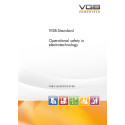With the coming into force of the German Industrial Safety Regulation (BetrSichV), the issue of operational safety at power plants has been increasingly dominated by the issue of functional safety.
Electrotechnical systems and components support or enable the power plant process; in addition, together with the auxiliary power demand system, they constitute a functional unit to be considered independently.
The question arose as to whether and to what extent, for purposes of risk minimisation, protective measures had to be applied for the electrotechnology by means of safety-related electrical, electronic or programmable electronic systems (E/E/PES). Only for these systems is a categorisation according to the safety integrity criteria necessary (e. g. the SIL Level).
The purpose of this VGB-Standard is, with respect to the electrotechnical systems and components of a power plant, to set out what essential rules should prevail regarding their characteristics and operation, and how these can be applied for purposes of implementing BetrSichV. In addition, it intends to make a contribution to a uniform understanding of the risk assessment of all electrotechnical systems and components of a power plant.
Chapter 3 begins by describing the hazards posed to electrotechnical systems and components, and then describes the main provisions regarding planning, engineering and construction. Certain advice is provided to help designers take risks appropriately into account during the planning stage. Chapter 4 begins by describing the operation and maintenance of electrotechnical systems in general terms from a standpoint of operational safety and occupational safety, and then proceeds to provide exemplary recommendations with respect to determining test intervals and the scope of inspection for select components.
Advice regarding the requirements applicable to the supply isolation of turbine generator sets from the turbine protection system and thermal/mechanical generator protection is provided in a separate chapter, Chapter 5.





